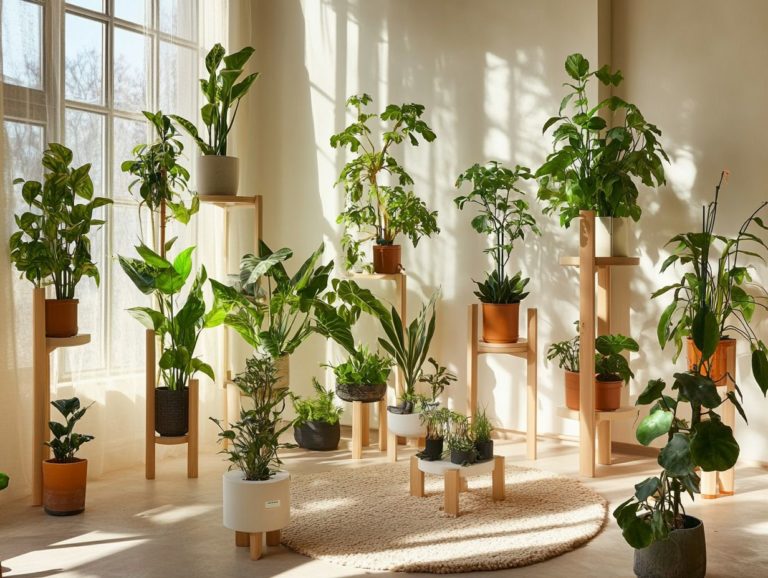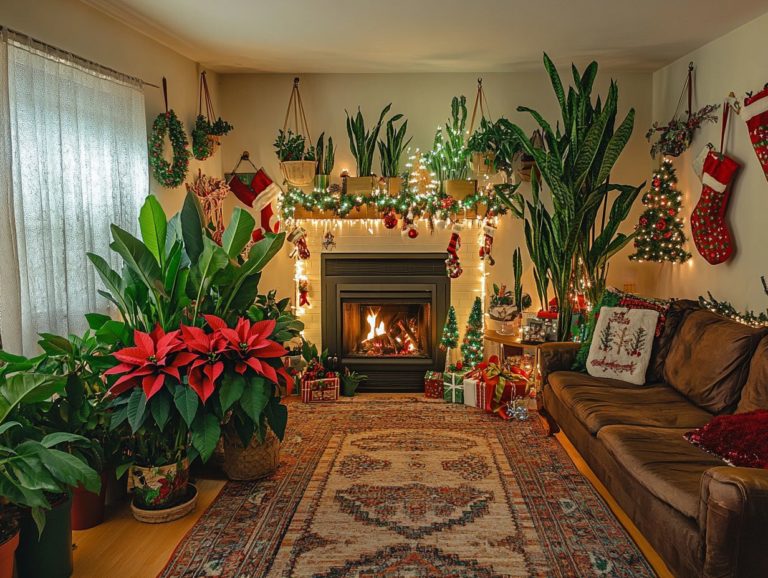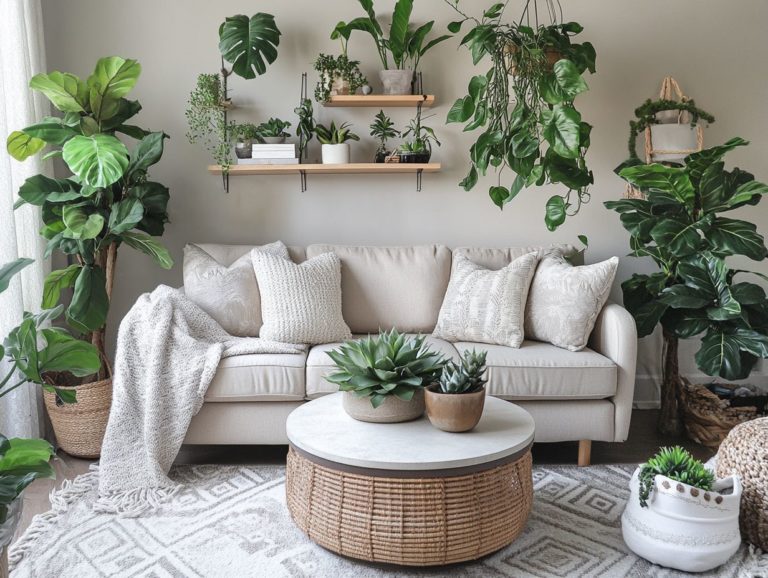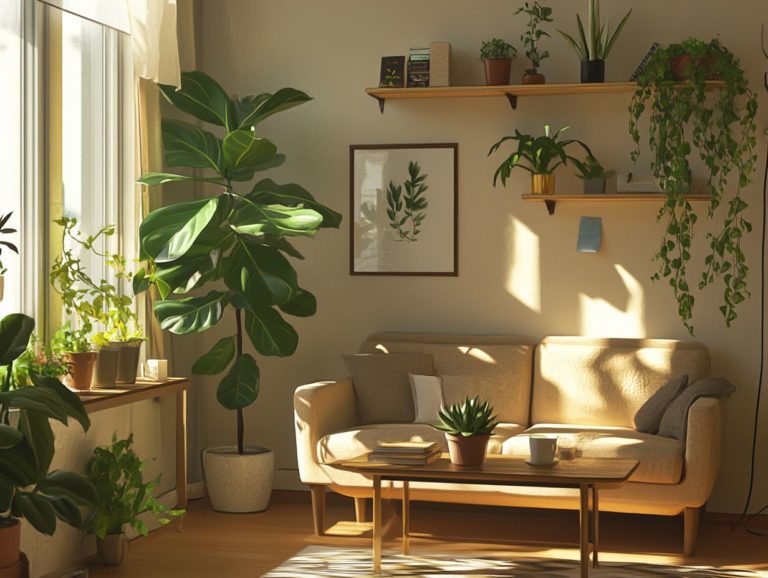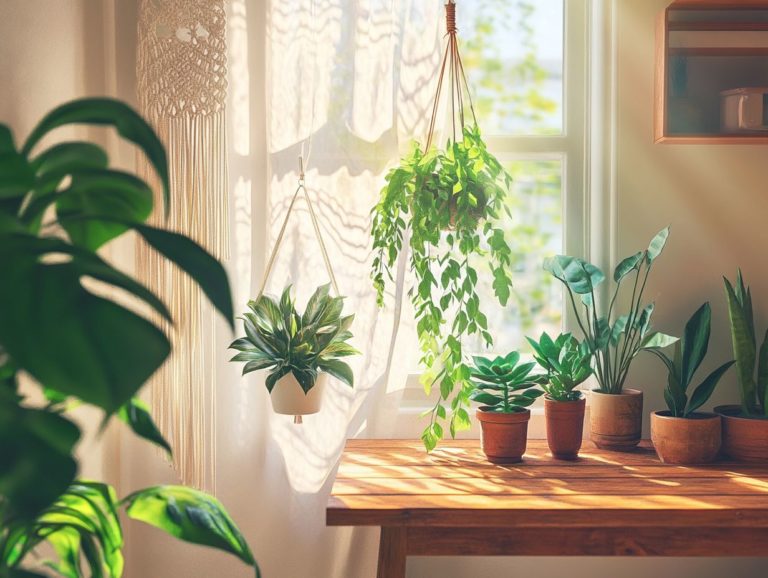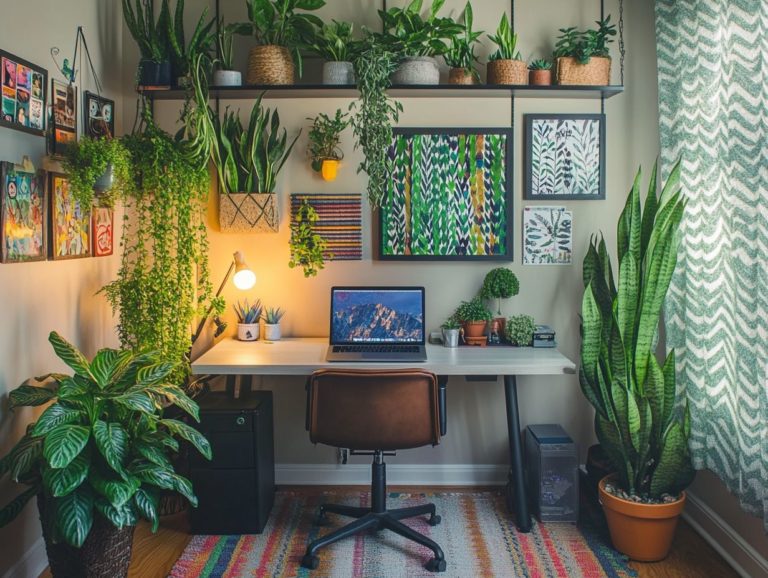Indoor Plant Decor: Tips for Seasonal Changes
Indoor plants have the remarkable ability to elevate your living space, infusing it with fresh air and vibrant color throughout the year.
As the seasons shift, so too do the needs of your plants. This article delves into the myriad benefits of indoor plants while guiding you in selecting the perfect varieties for each season.
Uncover essential care tips, explore creative decorating ideas, and learn about common pitfalls to avoid. These insights are designed to help your plants thrive and transform your home into a flourishing oasis.
Contents
- Key Takeaways:
- Benefits of Indoor Plants
- Choosing the Right Plants for Seasonal Changes
- Caring for Indoor Plants During Seasonal Changes
- Decorating with Indoor Plants for Each Season
- Common Mistakes to Avoid
- Frequently Asked Questions
- What are some tips for transitioning my indoor plant decor for seasonal changes?
- How often should I water my plants during seasonal changes, considering the different watering needs of houseplants?
- What are some ways to protect my plants during extreme temperature changes?
- How can I incorporate seasonal scents into my indoor plant decor?
- What types of plants are best for indoor plant decor during seasonal changes?
- How can I keep my indoor plant decor looking fresh and vibrant during seasonal changes?
Key Takeaways:

- Incorporating indoor plants into home decor has numerous benefits, including improved air quality and reduced stress levels.
- When choosing plants for seasonal changes, consider light and temperature requirements, and the plant’s ability to thrive in different climates.
- Properly caring for indoor plants during seasonal changes involves adjusting watering schedules and sunlight exposure, and regularly monitoring for common problems like pests or overwatering.
Benefits of Indoor Plants
Indoor plants provide a wealth of benefits, elevating not only the visual charm of your home but also positively influencing your wellbeing and indoor atmosphere.
Understanding horticulture can greatly enhance your indoor gardening experience. With a diverse selection of houseplants at your disposal, each suited to varying light, humidity levels, and care requirements, you have the opportunity to cultivate a vibrant indoor garden that flourishes year-round. Consider incorporating indoor plants to elevate your holiday decor for an added touch of beauty during the festive season.
Experts like Megan Hughes, a respected gardening expert, and renowned publications such as Better Homes & Gardens underscore the significance of choosing the right plants for your environment. This ensures they harmonize with the seasonal changes that can affect their growth and vitality. For inspiration, consider indoor plants that compliment your decor style.
Choosing the Right Plants for Seasonal Changes
Choosing the right houseplants for your indoor garden is essential. Seasonal changes can greatly impact their growth and health, so consider factors like humidity levels, sunlight exposure, and temperature fluctuations when selecting plants that can thrive all year.
Connecting with gardening experts like Joseph Tychonievich or diving into resources such as The Sill can provide invaluable insights into which plants are best suited for each season.
Factors to Consider
When selecting houseplants, several crucial factors can significantly influence their growth and longevity. Understanding the humidity levels, sunlight exposure, and temperature extremes in your environment is essential for ensuring your plants thrive throughout the year.
Common challenges like leaf drop (when leaves fall off, indicating the plant is stressed), pest control, and plant diseases should also be on your radar to maintain a healthy indoor sanctuary.
For instance, most houseplants flourish in humidity levels ranging from 40% to 60%. If the air is too dry, you might encounter browning leaf tips or stunted growth.
Proper lighting is essential, as different plants have varying sunlight needs. Inadequate light can result in leggy growth (plants that grow tall and spindly) and weakened stems.
Temperature fluctuations, especially cold drafts, can be detrimental. It s imperative to keep indoor temperatures stable between 65 F and 75 F. By recognizing these specific conditions, you can tackle common issues and ensure your plants remain vibrant and healthy.
Caring for Indoor Plants During Seasonal Changes
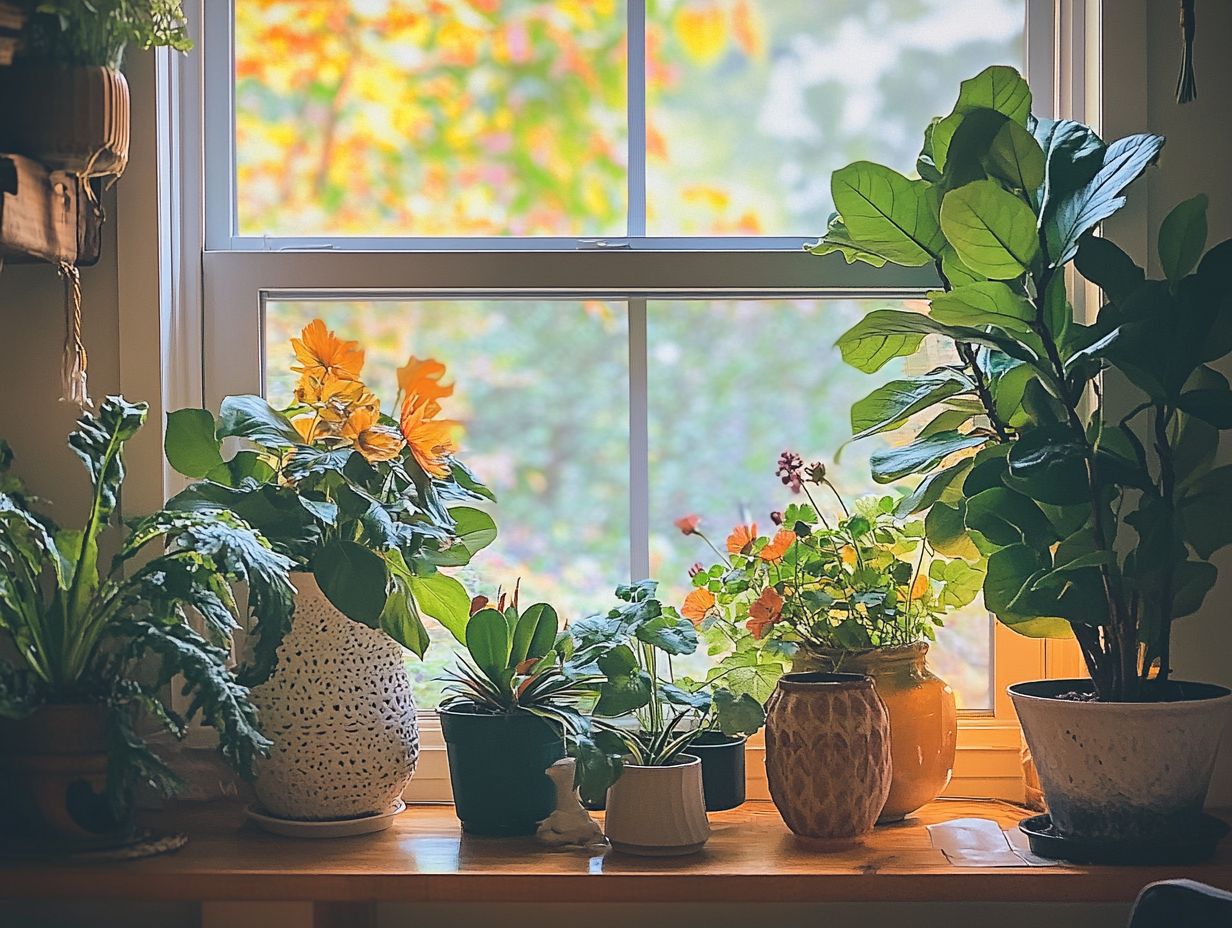
Caring for indoor plants during seasonal shifts demands a refined strategy to ensure they flourish amid changing conditions. For example, during the winter months, your houseplants may require modified watering practices and careful attention to humidity levels to counteract dry indoor air.
Understanding how these seasonal changes impact your indoor garden is crucial for fostering healthy plant growth and avoiding common challenges like leaf drop and pest infestations.
Transform your home into a vibrant oasis today! Start your indoor gardening journey and enjoy the benefits of beautiful plants in your living space.
Adjusting Watering and Sunlight
Adjusting the watering and sunlight exposure for your houseplants is crucial for their health as seasons change. As winter approaches and days grow shorter, your indoor plants may need less water and a strategic repositioning to make the most of the available sunlight. Understanding these adjustments can make a huge difference for your indoor garden’s resilience against seasonal challenges.
During the summer months, your houseplants likely thrive on more frequent watering, perhaps even daily, since increased sunlight and warmth speed up evaporation. In contrast, winter calls for a vigilant approach to soil moisture. Many plants enter a dormant phase, which is a period when they rest and grow slower, requiring water only when the top inch of soil feels dry. You can also enhance your home decor by using indoor plants for seasonal decor during these months.
As sunlight becomes scarce, consider relocating your plants to sunnier windows or utilizing grow lights to help maintain their vibrancy. For those looking to enhance their indoor space, exploring the best indoor plants for year-round beauty can provide great options. Recognizing these seasonal shifts gives you the power to keep your greenery thriving throughout the year.
Decorating with Indoor Plants for Each Season
Incorporating houseplants into your decor can truly transform your space, bringing the essence of seasonal changes right into your indoor garden. Whether you choose vibrant blooms that herald spring or lush greenery that soothes in winter, the right selection of houseplants can elevate your home s aesthetic and create an inviting atmosphere.
With a wealth of creative ideas available online and the potential for seasonal themes, decorating with plants is both beautiful and beneficial. For inspiration, check out these indoor plant styling tips for every room, especially when considering plant care practices.
Creative Ideas and Inspiration
Exploring creative ways to incorporate houseplants into your indoor garden can ignite your imagination for seasonal decorations that truly enliven your home. Innovate with unique pots, arrange plants by height, or craft themed displays for holidays. Each change in season presents a perfect opportunity to refresh your indoor space and elevate its visual appeal.
For instance, to celebrate spring, envision a vibrant display featuring blooming plants like tulips or daffodils nestled in colorful ceramic pots perfect for brightening any corner. Additionally, consider incorporating the top 5 indoor plants for seasonal decor to enhance your arrangements. When autumn rolls around, cluster smaller plants in rustic planters alongside decorative gourds to evoke that inviting, warm harvest vibe.
As winter settles in, consider how evergreen arrangements can transform your coffee table, especially when dressed up with twinkling fairy lights. Encouraging yourself to experiment with different textures and colors not only sparks creativity but also personalizes your indoor garden experience. For some great ideas, check out the top 5 indoor plants for seasonal changes. This way, every season becomes an opportunity for fresh inspiration and a chance to express your unique style.
Common Mistakes to Avoid
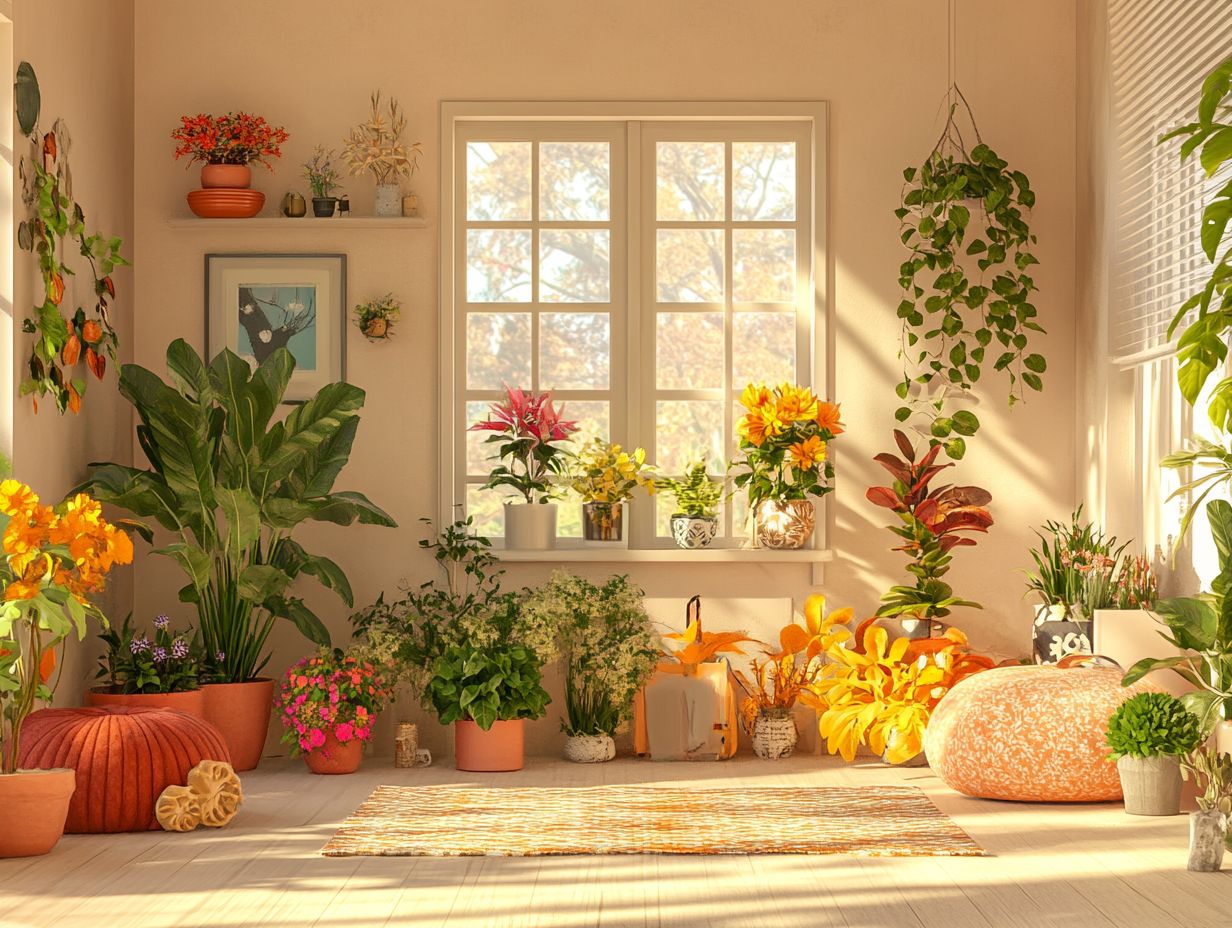
Steering clear of common mistakes in plant care can greatly elevate the health and beauty of your houseplants as the seasons shift. Challenges like leaf drop, improper watering techniques, and overlooked pest control can affect even the most dedicated indoor gardeners.
By identifying these potential pitfalls, you position yourself to cultivate an indoor garden that thrives and remains vibrant throughout the year. Act now to prevent leaf drop!
Troubleshooting and Tips for Success
Effective troubleshooting strategies can truly elevate the success of your indoor garden. By grasping common issues related to watering tips, pest control, and humidity levels, you can proactively ensure your houseplants flourish.
Regular monitoring and adjustments are essential for preventing problems and fostering healthy plant growth. Recognizing signs of distress in your plants like yellowing leaves or stunted growth is also important.
Establishing a consistent watering schedule that accounts for seasonal changes and the specific needs of each plant is crucial. Integrating natural pest control methods, such as introducing beneficial insects or utilizing insecticidal soaps, offers an environmentally friendly way to maintain plant health.
Don t underestimate the significance of humidity. Employing a humidity meter can help you create an ideal environment for tropical species that thrive in moist conditions.
By embracing these proactive measures, including utilizing a moisture meter and understanding fertilizer pause practices, you can cultivate a lush and vibrant collection of indoor plants that will surely impress. Start your indoor gardening journey today and watch your plants thrive!
Frequently Asked Questions
What are some tips for transitioning my indoor plant decor for seasonal changes?
One tip is to replace summer plants with winter-friendly ones, such as succulents or evergreens.
Another tip is to rotate your plants to different areas of your home to give them optimal sunlight and temperature for the season.
You can also add seasonal decorations, such as pine cones or pumpkins, to your plant arrangements, and don’t forget to consider when to water houseplants to match the current season.
How often should I water my plants during seasonal changes, considering the different watering needs of houseplants?
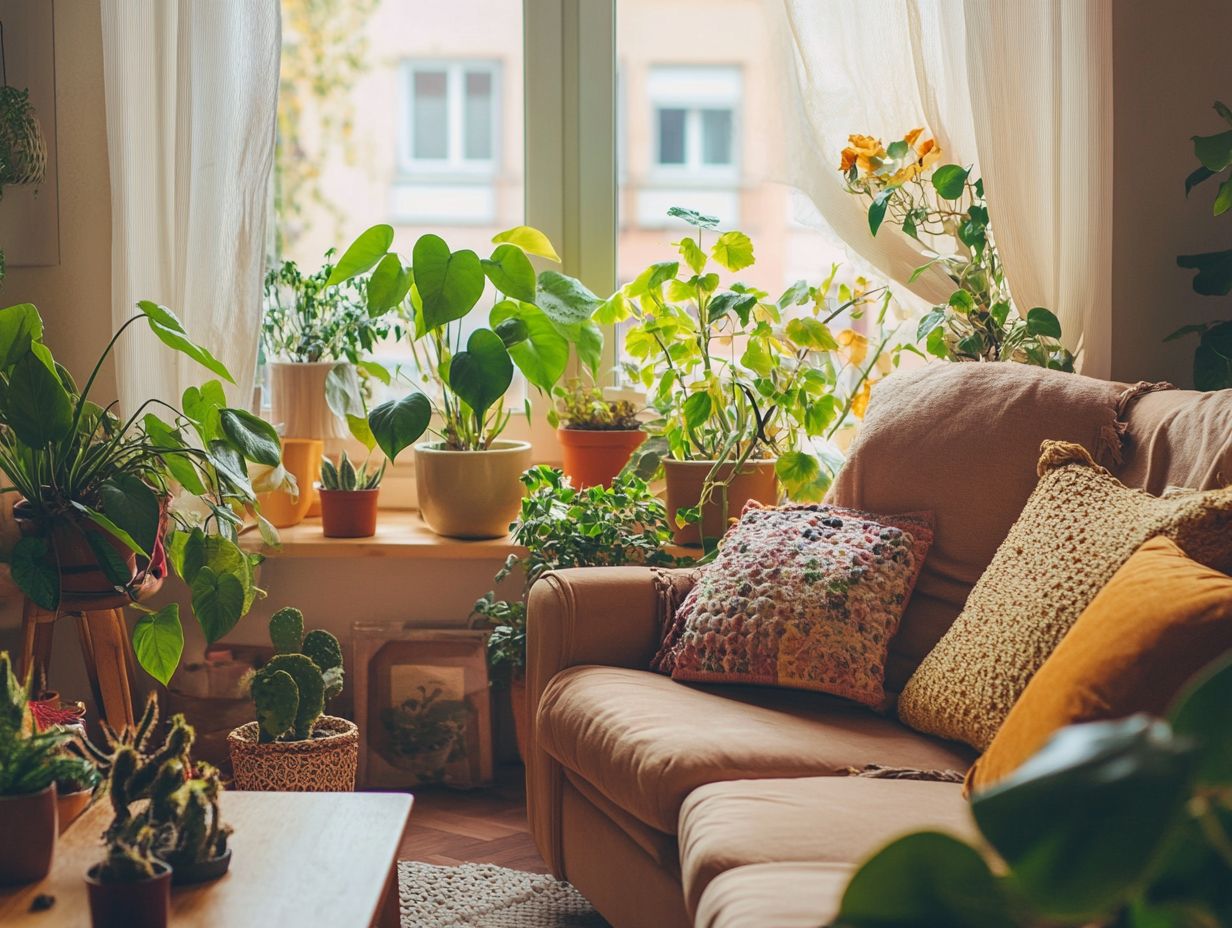
The watering frequency for your plants may change with the seasons. It’s important to check the soil moisture regularly and adjust your watering schedule accordingly.
If you live in a dry climate, you may need to water more often during the winter months when the air is drier. In contrast, if you live in a humid climate, you may need to decrease watering during the winter when plants may not dry out as quickly.
Understanding your local humidity can greatly improve your plant care routine.
What are some ways to protect my plants during extreme temperature changes?
If you live in an area with harsh winters, consider moving your plants away from drafty windows or doors to protect them from cold drafts. This is a crucial tip for keeping your indoor plants thriving in winter.
Invest in a humidifier to keep your plants’ environment moist during the dry winter months, helping to improve humidity levels for your houseplants.
For summer heat waves, provide extra shade for your plants and ensure they are not placed directly in front of air conditioning units, as the temperature extremes can stress your indoor plants.
How can I incorporate seasonal scents into my indoor plant decor?
You can add essential oils, such as pine or cinnamon, to your plant’s soil for a natural and subtle scent. This can enhance your indoor gardening experience during seasonal changes.
Another option is to place scented candles near your plants, but make sure they are not too close to avoid heat damage. Dried herbs, such as rosemary or lavender, can also be added to your plant arrangements for a pleasant aroma. Additionally, exploring indoor plant trends that will elevate your decor can enhance the overall aesthetic of your space.
What types of plants are best for indoor plant decor during seasonal changes?
Plants that can thrive in varying temperatures and light conditions, such as spider plants or pothos, are great options for indoor plant decor during seasonal changes. Gardening experts like Megan Hughes recommend these resilient choices.
Plants with evergreen leaves, such as philodendrons or ferns, are also a good choice as they provide a pop of greenery all year round.
It’s best to research the specific needs of each plant, including their sunlight exposure and watering needs, and choose ones that can adapt well to changing seasons.
How can I keep my indoor plant decor looking fresh and vibrant during seasonal changes?
Dust and clean your plants regularly. This keeps them healthy and prevents problems like leaf drop and pests.
Prune dead or wilted leaves and stems. This promotes new growth and rejuvenates your plants.
Repot your plants if they have outgrown their containers or if the soil is old and depleted. These simple steps will ensure your plants thrive!

